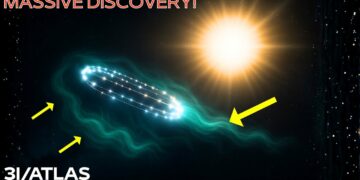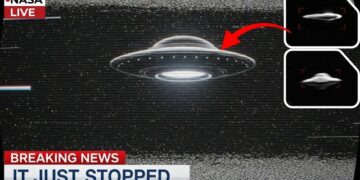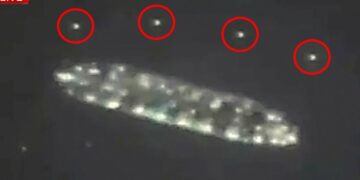For nearly five decades, Voyager 1 has journeyed alone through the vast, silent expanse beyond our solar system. This aging spacecraft, the farthest human-made object in history, has ventured deeper than any probe before it. Often regarded as a cosmic ghost ship, it silently carries Earth’s hopes, data, and memories. Scientists anticipated a gradual weakening of its signals as its systems aged and power dwindled. Yet, just when they believed Voyager 1 was nearing its end, something extraordinary happened. The spacecraft altered its course—not due to a command from Earth or a mechanical failure, but seemingly of its own accord. Even more unsettling, days before this change, Voyager 1 detected a low-frequency hum with no identifiable source, unmatched in NASA’s records, and without scientific explanation. With its antenna still aimed at Earth, Voyager is now heading back—or being drawn back. What did it encounter in the void? What prompted its turn?
To grasp the significance of this moment, we must revisit the beginning. In 1977, NASA launched Voyager 1 and Voyager 2 to exploit a rare planetary alignment occurring once every 176 years. Their mission was a grand tour of the outer planets, using the gravitational slingshot effect of Jupiter, Saturn, Uranus, and Neptune to propel them deeper into space. Voyager 1’s task was to fly by Jupiter and Saturn, capturing the first close-up images of their moons and rings. Its late 1970s and early 1980s images—of Io’s erupting volcanoes, Saturn’s intricate rings, and Titan’s mysterious haze—revolutionized planetary science. After completing its planetary mission, Voyager 1 continued onward, passing Pluto’s orbit, the heliosphere, and entering interstellar space, a realm untouched by human technology. Despite sending back less data each year, it persisted in its mission to explore, even as its systems grew colder and the sun’s light faded to a memory.
In its 46th year, Voyager 1’s instruments detected something unprecedented: a faint, continuous hum within plasma wave frequencies. Initially dismissed as interference or a malfunction, the signal persisted and was confirmed by multiple antennas in the Deep Space Network. It matched no known cosmic phenomenon—not cosmic background radiation, solar flares, or any triangulable source. Strangely, it fluctuated in precise mathematical intervals, resembling a message not meant to be heard but recorded. Scientists analyzed the data for weeks, finding no explanation. Then, unexpectedly, Voyager 1 shifted its trajectory without NASA’s input, raising the question: what—or who—caused this?
Powered by an aging radioisotope thermoelectric generator, Voyager 1’s maneuvering capabilities are limited to small thrusters, unused for years. Yet, telemetry confirmed a deliberate reorientation, as if aligning with something in deep space. Engineers investigated whether this was a pre-programmed response or a sensor glitch, but no such command was found. More puzzling, the shift pointed Voyager’s long-dormant camera array—unused since the 1990 “Pale Blue Dot” image—toward a region with no known stars, galaxies, or gravitational anomalies. Why aim there? What had Voyager detected?
At over 15 billion miles from Earth, Voyager operates without real-time guidance. Yet, it seemed to act autonomously. Subsequent transmissions revealed subtle signal distortions, with patterns embedded in the data stream—intentional modulations forming complex sequences akin to binary logic and harmonic resonance. Experts, including cryptographers and linguists, analyzed these patterns, some suggesting they indicated a response or observation, as if Voyager was being watched. The possibility that this was two-way communication, linked to the Golden Record—a disc carrying greetings, music, and Earth’s coordinates—raised profound questions. Could Voyager have encountered an intelligence using unconventional communication methods, like gravitational waves or magnetic distortions? If so, has it noticed us?
At NASA’s Jet Propulsion Laboratory, a select team debated the anomaly. Some attributed it to failing hardware, but others noted the signal’s consistency and precise course change, suggesting an interaction with an unknown phenomenon or entity. The patterns—geometric ratios, symmetrical intervals, and harmonic feedback—hinted at deliberate structure. The question arose: what if this isn’t random?
As the scientific community caught wind of the data, theories emerged. Some proposed Voyager had entered a dark matter field or a space-time distortion. A particularly unsettling hypothesis came from AI researchers who found similarities between Voyager’s signal patterns and the 1974 Arecibo message, humanity’s binary transmission to the stars. This raised the possibility that an intelligence had received our signal and was responding via Voyager.
The Golden Record, a symbolic gesture carrying Earth’s story, now took on new significance. Its detailed maps of Earth’s location could have been decoded by something Voyager encountered, turning the spacecraft into a beacon broadcasting our coordinates for nearly half a century. NASA has shifted to classifying the event as a “data anomaly,” discouraging speculation about non-natural causes. Yet, privately, some insiders admit the signals suggest an interaction—something adaptive, aware, and unlike any known astrophysical behavior.
Voyager 1, never designed to last this long or make contact, may have done just that. Its mission, initially to explore outer planets, has become a cosmic enigma, brushing against philosophy and unease. The signal distortions, impossible course correction, and mirrored patterns suggest Voyager may have encountered something vast and structured—not life as we imagine, but something watching. If this is Voyager’s final chapter, it ends with a question: what if we are no longer the observers, but the observed?
What do you think? Has Voyager 1 encountered something unnatural? Is this a new era in exploration or the end of a story we weren’t meant to hear? Share your thoughts, and if this story sparks wonder or unease, spread the word. Voyager may have sent back more than data—it may have sent a message, and we might not be the only ones listening.























